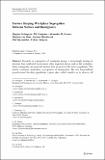Factors shaping workplace segregation between natives and immigrants
Abstract
Research on segregation of immigrant groups is increasingly turning its attention from residential areas toward other important places, such as the workplace, where immigrants can meet and interact with members of the native population. This article examines workplace segregation of immigrants. We use longitudinal, georeferenced Swedish population register data, which enables us to observe all immigrants in Sweden for the period 1990-2005 on an annual basis. We compare estimates from ordinary least squares with fixed-effects regressions to quantify the extent of immigrants' self-selection into specific workplaces, neighborhoods, and partnerships, which may bias more naïve ordinary least squares results. In line with previous research, we find lower levels of workplace segregation than residential segregation. The main finding is that low levels of residential segregation reduce workplace segregation, even after we take into account intermarriage with natives as well as unobserved characteristics of immigrants' such as willingness and ability to integrate into the host society. Being intermarried with a native reduces workplace segregation for immigrant men but not for immigrant women.
Citation
Strömgren , M , Tammaru , T , Danzer , A M , van Ham , M , Marcińczak , S , Stjernström , O & Lindgren , U 2014 , ' Factors shaping workplace segregation between natives and immigrants ' , Demography , vol. 51 , no. 2 , pp. 645-671 . https://doi.org/10.1007/s13524-013-0271-8
Publication
Demography
Status
Peer reviewed
ISSN
0070-3370Type
Journal article
Description
The research reported in this article was made possible in part through the financial support of the Estonian Research Council (Institutional Research Grant IUT2-17 on Spatial Population Mobility and Geographical Changes in Urban Regions); the Estonian Science Foundation (Grant No. 8774 and 9247); the NORFACE research program Migration in Europe―Social, Economic, Cultural and Policy Dynamics (MIDI-REDIE); the EU Career Integration Grant (PCIG10-GA-2011-303728, call identifier FP7-PEOPLE-2011-CIG) (NBHCHOICE); and the Umeå SIMSAM Network―Register-based Research Program Connecting Childhood with Lifelong Health and Welfare funded by the Swedish Research Council (Grant No. 2008-28784-63564-191).Collections
Items in the St Andrews Research Repository are protected by copyright, with all rights reserved, unless otherwise indicated.

